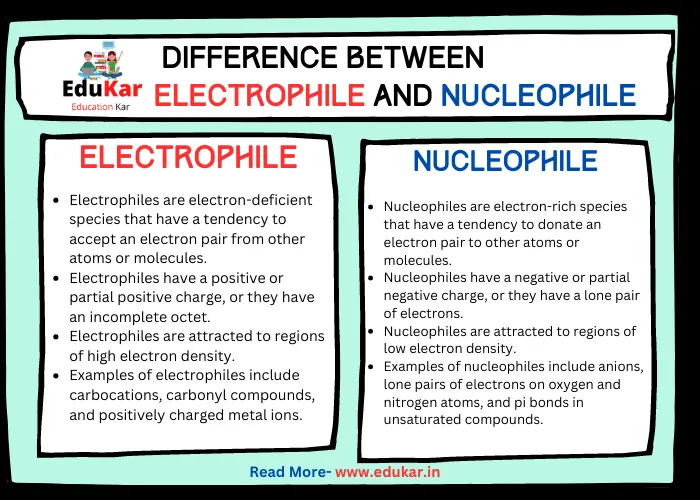Contents
- 1 Introduction
- 2 Electrophiles
- 3 Nucleophiles
- 4 Differences between Electrophiles and Nucleophiles
- 5 Applications
- 6 Conclusion
- 7 FAQs
- 7.1 What is an electrophile?
- 7.2 What is a nucleophile?
- 7.3 What is the main difference between an electrophile and a nucleophile?
- 7.4 How do electrophiles and nucleophiles react in organic chemistry?
- 7.5 What are some examples of electrophiles?
- 7.6 What are some examples of nucleophiles?
- 7.7 How do electrophiles and nucleophiles differ in terms of charge?
- 7.8 How can the difference between electrophiles and nucleophiles be used in organic synthesis?
Learn about the fundamental concepts of electrophiles and nucleophiles and how they differ in their behavior and reactivity. Discover how they interact with other molecules and their role in organic chemistry reactions. In this blog, we will explore the differences between electrophiles and nucleophiles, their characteristics, and their applications in chemical reactions.

Introduction
Electrophiles and nucleophiles are fundamental concepts in organic chemistry. These terms are used to describe how molecules interact with each other in chemical reactions. Understanding the difference between electrophiles and nucleophiles is essential in predicting the outcome of many chemical reactions.
Electrophiles
An electrophile is a species that is attracted to electrons and seeks to gain them. Electrophiles are electron-deficient, meaning they have a positive charge or are lacking electrons in their outer shell. Electrophiles are attracted to electron-rich regions and can attack molecules that have a high electron density. This can result in a chemical reaction.
Examples of electrophiles include protons, carbocations, and positive ions. Protons, for example, are attracted to negatively charged regions in molecules, such as the lone pair of electrons on a nitrogen atom. Carbocations, on the other hand, are positively charged ions that are electron-deficient and are attracted to electron-rich regions in molecules.
Nucleophiles
Nucleophiles are species that have an excess of electrons and are attracted to electron-deficient regions in molecules. Nucleophiles have a negative charge or have a lone pair of electrons that they can donate to form a new bond. Nucleophiles attack electron-deficient regions in molecules and can result in a chemical reaction.
Examples of nucleophiles include hydroxide ions, amines, and halides. Hydroxide ions, for example, are attracted to positively charged regions in molecules, such as the carbonyl group in aldehydes and ketones. Amines are nucleophiles that have a lone pair of electrons that can donate to form a new bond. Halides are also nucleophiles that can attack electron-deficient regions in molecules.
Differences between Electrophiles and Nucleophiles
| Electrophile | Nucleophile |
|---|---|
| Electrophiles are electron-deficient species that have a tendency to accept an electron pair from other atoms or molecules. | Nucleophiles are electron-rich species that have a tendency to donate an electron pair to other atoms or molecules. |
| Electrophiles have a positive or partial positive charge, or they have an incomplete octet. | Nucleophiles have a negative or partial negative charge, or they have a lone pair of electrons. |
| Electrophiles are attracted to regions of high electron density. | Nucleophiles are attracted to regions of low electron density. |
| Examples of electrophiles include carbocations, carbonyl compounds, and positively charged metal ions. | Examples of nucleophiles include anions, lone pairs of electrons on oxygen and nitrogen atoms, and pi bonds in unsaturated compounds. |
| Electrophilic reactions involve the addition of an electrophile to a nucleophile. | Nucleophilic reactions involve the addition of a nucleophile to an electrophile. |
| Electrophilic reactions are typically exothermic, releasing energy. | Nucleophilic reactions are typically endothermic, requiring energy to proceed. |
| Electrophilic reactions are commonly used in organic chemistry to form new carbon-carbon and carbon-heteroatom bonds. | Nucleophilic reactions are commonly used in organic chemistry to form new carbon-oxygen, carbon-nitrogen, and carbon-halogen bonds. |
| Electrophiles are often reactive intermediates in organic synthesis. | Nucleophiles are often used as reagents in organic synthesis. |
| Electrophiles can cause damage to biological molecules like proteins and DNA, leading to mutations and diseases. | Nucleophiles are involved in many biochemical reactions, such as enzyme-catalyzed reactions and DNA replication. |
| Electrophiles are typically small and compact molecules. | Nucleophiles can be large and bulky molecules. |
Applications
The understanding of electrophiles and nucleophiles is critical in organic chemistry, and they have various applications in chemical reactions. For example, electrophilic substitution is a reaction where an electrophile attacks an electron-rich aromatic ring, such as benzene.
Nucleophilic substitution is a reaction where a nucleophile attacks an electron-deficient atom, such as a carbon atom with a leaving group attached.
Addition reactions are another example of the application of electrophiles and nucleophiles. In these reactions, an electrophile and a nucleophile combine to form a new bond.
Elimination reactions are also another example of the application of electrophiles and nucleophiles. In these reactions, a leaving group is removed from a molecule, and an electron pair is shared between two atoms.
Conclusion
Understanding the difference between electrophiles and nucleophiles is essential in predicting the outcome of many chemical reactions. Electrophiles are attracted to electron-rich regions, while nucleophiles are attracted to electron-deficient regions. Their difference in charge and electron density determines their ability to attack molecules and participate in chemical reactions. The knowledge of electrophiles and nucleophiles is essential in organic chemistry and has various applications in chemical reactions.
FAQs
What is an electrophile?
An electrophile is an atom or molecule that can accept a pair of electrons to form a new covalent bond.
What is a nucleophile?
A nucleophile is an atom or molecule that can donate a pair of electrons to form a new covalent bond.
What is the main difference between an electrophile and a nucleophile?
The main difference between an electrophile and a nucleophile is their electron-seeking behavior. An electrophile seeks electrons to form a new covalent bond, while a nucleophile donates electrons to form a new covalent bond.
How do electrophiles and nucleophiles react in organic chemistry?
Electrophiles and nucleophiles react in organic chemistry by participating in nucleophilic substitution reactions. In these reactions, the nucleophile attacks the electrophile, displacing a leaving group and forming a new bond.
What are some examples of electrophiles?
Examples of electrophiles include carbocations, positively charged metal ions, and electron-deficient carbon atoms.
What are some examples of nucleophiles?
Examples of nucleophiles include anions such as hydroxide (OH-), chloride (Cl-), and cyanide (CN-), as well as neutral molecules such as water (H2O) and ammonia (NH3).
How do electrophiles and nucleophiles differ in terms of charge?
Electrophiles are often positively charged or have a partial positive charge, while nucleophiles are often negatively charged or have a partial negative charge.
How can the difference between electrophiles and nucleophiles be used in organic synthesis?
The difference between electrophiles and nucleophiles can be used in organic synthesis to selectively introduce new functional groups or modify existing ones. By choosing the appropriate reagents and reaction conditions, chemists can control the outcome of a reaction based on the electron-seeking behavior of the electrophile and nucleophile involved.
















